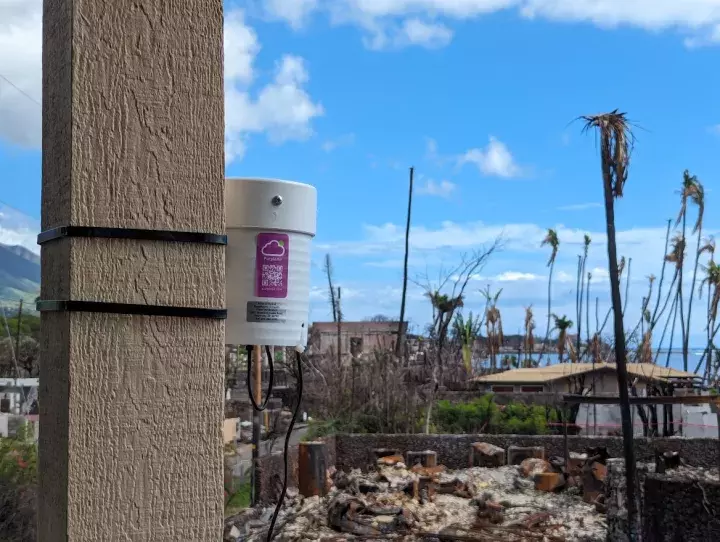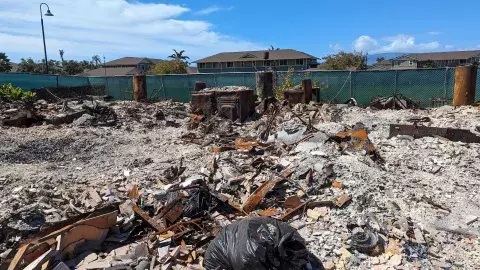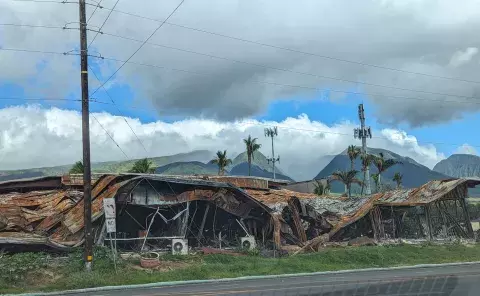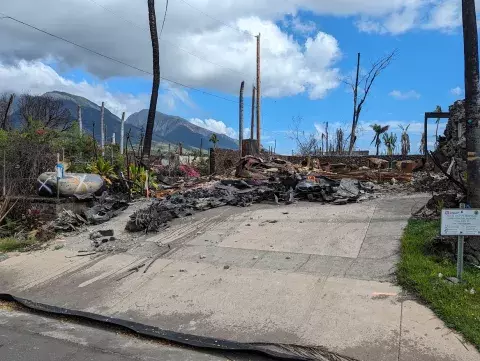
The Wildland Urban Interface (WUI) fire that destroyed the town, Lahaina, on the Hawaiian island of Maui is likely to have extensive long-term impacts on environmental and human health. The acute impacts of the event included the confirmed loss of 101 lives. The authorities estimate that more than 4,500 households have been displaced and over 2,000 structures have been destroyed.
The numerous historical dwellings and businesses in the National Historic District of Lahaina as well as recently constructed buildings are included in this total. This structural age range in the impacted area means that legacy contaminants, such as lead from pre-1970’s paint and arsenic from ceilings and wallboard made from sugarcane, are likely intermixed with chemical and metal hazards associated with newer materials, like burned modern vehicles, consumer electronics, and synthetic building and furnishing materials.
This complex mixture of hazardous substances represents a significant threat to residents as they evaluate the damage to their homes and begin the process of debris removal and rebuilding. Robust environmental characterization of this hazardous residual material is required to comprehensively evaluate the availability of fire-related environmental exposures among residents.
EWC is collaborating with the Chemical Insights Research Institute of UL Research Institutes and Duke University to systematically collect dust, soil, and ash samples from a sample of property boundaries. Where possible, the team will collect samples from within the remains of individual rooms and garages/carports, based on the remaining structures and foundation footprints, of burned buildings.
The team will obtain high-resolution remote sensing images during sampling to assist with determining the presence of remnants of specific items, such as automobiles, watercraft, refrigerators, washers & dryers, and other identifiable items. Samples collected near these types of items will be annotated for comparison to other samples where these items were absent. Samples from the property will be evaluated for non-volatile and volatile chemical and elemental hazards using analytical chemistry techniques.
The team will also administer a limited number of survey questions, primarily around property history that are part of the data collection/site survey process. This study will obtain valuable data on chemical and heavy metal residues present after the fire that may present environmental health challenges to those exposed. The information can lead to mitigation approaches and recommended processes for reducing exposures and protecting public health.
Project Team
Dr. Sumeet Saksena, Senior Fellow, EWC
Dr. Mark Wilson, Director, Exposure Science, Chemical Insights Research Institute of ULRI
Mr. David Kalafut, Research Scientist, Chemical Insights Research Institute of ULRI
Dr. Junfeng Zhang, Professor, Nicholas School of the Environment, Duke University
Dr. Marilyn Black, Vice President, Chemical Insights Research Institute of ULRI
The Wildland Urban Interface (WUI) fire that destroyed the town, Lahaina, on the Hawaiian island of Maui is likely to have extensive long-term impacts on environmental and human health. The acute impacts of the event included the confirmed loss of 101 lives. The authorities estimate that more than 4,500 households have been displaced and over 2,000 structures have been destroyed.
The numerous historical dwellings and businesses in the National Historic District of Lahaina as well as recently constructed buildings are included in this total. This structural age range in the impacted area means that legacy contaminants, such as lead from pre-1970’s paint and arsenic from ceilings and wallboard made from sugarcane, are likely intermixed with chemical and metal hazards associated with newer materials, like burned modern vehicles, consumer electronics, and synthetic building and furnishing materials.
This complex mixture of hazardous substances represents a significant threat to residents as they evaluate the damage to their homes and begin the process of debris removal and rebuilding. Robust environmental characterization of this hazardous residual material is required to comprehensively evaluate the availability of fire-related environmental exposures among residents.
EWC is collaborating with the Chemical Insights Research Institute of UL Research Institutes and Duke University to systematically collect dust, soil, and ash samples from a sample of property boundaries. Where possible, the team will collect samples from within the remains of individual rooms and garages/carports, based on the remaining structures and foundation footprints, of burned buildings.
The team will obtain high-resolution remote sensing images during sampling to assist with determining the presence of remnants of specific items, such as automobiles, watercraft, refrigerators, washers & dryers, and other identifiable items. Samples collected near these types of items will be annotated for comparison to other samples where these items were absent. Samples from the property will be evaluated for non-volatile and volatile chemical and elemental hazards using analytical chemistry techniques.
The team will also administer a limited number of survey questions, primarily around property history that are part of the data collection/site survey process. This study will obtain valuable data on chemical and heavy metal residues present after the fire that may present environmental health challenges to those exposed. The information can lead to mitigation approaches and recommended processes for reducing exposures and protecting public health.
Project Team
Dr. Sumeet Saksena, Senior Fellow, EWC
Dr. Mark Wilson, Director, Exposure Science, Chemical Insights Research Institute of ULRI
Mr. David Kalafut, Research Scientist, Chemical Insights Research Institute of ULRI
Dr. Junfeng Zhang, Professor, Nicholas School of the Environment, Duke University
Dr. Marilyn Black, Vice President, Chemical Insights Research Institute of ULRI




